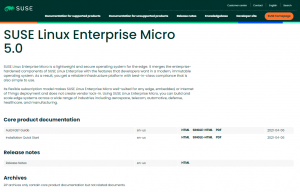SUSE Linux Enterprise Micro 5.0 docs support mega-easy installation
SUSE Linux Enterprise Micro is a modern system primarily designed for edge computing. The main features of SUSE Linux Enterprise Micro are predictability and reliability, thanks to the read-only root file system and transactional updates. The read-only file system ensures that the system cannot be altered during runtime and that the system behaves the same way after each reboot. Transactional updates enable you to update the system without influencing the running system and always provide a rollback.
For SUSE Linux Enterprise Micro 5.0, we have currently released the following documentation (a huge “thank you” goes to Jana Halackova for the docs and Lukáš Kucharczyk for the release notes):

Release Notes
The release notes document provides a high-level overview of features, capabilities, and limitations of SUSE Linux Enterprise Micro 5.0.
The release notes are structured identical across all architectures. They are updated periodically, and the latest version is always available at https://www.suse.com/releasenotes. Release notes usually only list changes that happened between two subsequent releases. Entries can be listed twice if they are important and belong to more than one section. Also, certain important entries from the release notes of previous product versions are repeated.
The release notes usually are the first go-to source if you want to be informed about new features of or changes in the product.
Installation Quick Start
On thirteen easy-to-follow pages, the Quick Start guides you step-by-step through the installation of SUSE Linux Enterprise Micro 5.0. After getting an overview of the product and the hardware requirements, you can choose from three different installation procedures for your system:
- Manual installation
- Unattended automatic installation by using AutoYaST
- Deployment of prebuilt images
AutoYaST Guide
If you need to rely on an unattended mass deployment, there is an extra AutoYaST Guide available for the installation of your SUSE Linux Enterprise Micro systems.
Standard installations of SUSE Linux Enterprise Micro are based on a wizard workflow. This is user-friendly and efficient when installing on few machines. However, it becomes repetitive and time-consuming when installing on many machines.
AutoYaST can be used where no user intervention is required or where customization is required. The installation is defined by an XML configuration file that contains installation and configuration data and is called the “AutoYaST profile”. You can create this using existing configuration resources, and easily tailor it for any specific environment. Using the AutoYaST profile, YaST prepares the system for a custom installation and does not interact with the user, unless specified in the file controlling the installation.
The book guides you through the three basic steps of auto-installation:
- Preparation: All relevant information about the target system is collected and turned into the appropriate directives in the profile. The profile is transferred onto the target system where its directives will be parsed and fed into YaST.
- Installation: YaST performs the installation and basic configuration (for example, partitioning, networking, firewall) of the target system using the data from the AutoYaST profile.
- Post-configuration: After the installation and configuration of the basic system, the system can run a second stage to perform any additional configuration that requires the target system to be already running, such as post-installation scripts, third party modules or even some YaST modules.
There is surely more to come during the next months – we will keep you informed! Now – enjoy reading the docs while installing SUSE Linux Enterprise Micro 5.0.
Related Articles
Jun 08th, 2022
SUSE HA for SAP HANA scale-up cost-optimized improved
Oct 04th, 2022
The First Prototype of Adaptable Linux Platform is Live
Aug 01st, 2022